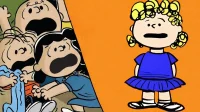The Curious Case of Charlotte Braun: Peanuts’ Forgotten Female Counterpart
Charlie Brown and his fellow Peanuts characters hold an enduring place in the landscape of popular culture, recognized and cherished by generations. Despite the overwhelming fame enjoyed by characters such as Linus, Lucy, Sally, and Snoopy, there remains one lesser-known figure whose presence is hardly remembered: Charlotte Braun, famously dubbed the ‘female Charlie Brown.’ Once a part of the Peanuts ensemble, Charlotte’s legacy has faded, particularly after her untimely demise, executed by none other than Charles M. Schulz himself.
The Introduction of Charlotte Braun
Charlotte Braun made her debut in the Peanuts comic strip on November 30, 1954. From her introduction, it was clear that she was intended as Charlie Brown’s female counterpart, as she referred to herself as “Good ol’ Charlotte Braun.” This playful nod to Charlie Brown’s name hints at the parallels between the two. However, distinct personality traits emerged: while Charlie Brown is typically portrayed as quiet and contemplative, Charlotte was characterized by her loud and bold demeanor, creating an interesting contrast.





Fan Backlash and the Fate of Charlotte Braun
Charlotte Braun’s appearances in the strip frequently highlighted her boisterous nature, often leading the other Peanuts characters, especially Charlie Brown, to express their disdain for her antics. The response from the audience was overwhelmingly negative, with numerous letters pouring in to Schulz, urging him to eliminate her from the comic. This backlash ultimately led to Schulz’s decision to retire Charlotte, marking her as a character whose time had come to an abrupt end.
Schulz’s Dark Sense of Humor
Schulz made this decision known in a striking letter addressed to a concerned fan, which is now preserved in the United States Library of Congress. In this correspondence, he humorously warned the fan that if they ever came across Charlotte again, it would be in previously completed strips. He chillingly noted that they would be bearing “the death of an innocent child”on their conscience. The full text reads:
“Dear Miss Swaim, I am taking your suggestion regarding Charlotte Braun and will eventually discard her. If she appears anymore it will be in strips that were already completed before I got your letter or because someone writes in saying that they like her. Remember, however, that you and your friends will have the death of an innocent child on your conscience. Are you prepared to accept such responsibility? Thanks for writing, and I hope that future releases will please you. Sincerely, Charles M. Schulz.”
In a playful yet morbid twist, Schulz included an illustration in the letter showing Charlotte with an ax embedded in her head, reinforcing the notion that this was indeed a definitive end for her character. This sketch not only served as a darkly humorous visual pun but also posited Charlotte’s demise as a canonical event in the Peanuts universe.
A Surprising Resurrection
In the Digital Realm: Charlotte Lives On
While Schulz’s pen might have spelled death for Charlotte Braun in the comic strips, she surprisingly resurfaced in broader Peanuts media. In the 2015 mobile game Snoopy’s Town Tale, players can interact with Charlotte, which indicates that the character did not meet her end as definitively as Schulz suggested. Instead, it appears the rest of the Peanuts gang chose to distance themselves from her loud personality.
This unexpected appearance in a digital format blurs the lines between canon and non-canon, leading fans to question whether Schulz’s grim drawing represented a whimsical joke rather than a literal termination of Charlotte’s character. Nonetheless, while Charlotte may have reappeared in the gaming realm, her comic strip demise remains a significant chapter in Peanuts history, illustrating Schulz’s wry sense of humor and the sometimes dark undercurrents lurking within seemingly innocent comic strips.
In the end, Charlotte Braun stands as a fascinating illustration of how a character can both be forgotten and remembered within different contexts of a beloved series. Her dual existence in the Peanuts universe serves not only as an intriguing footnote to the legacy of Charles M. Schulz but also as a striking reminder of the rich storytelling potential within comic narratives.


